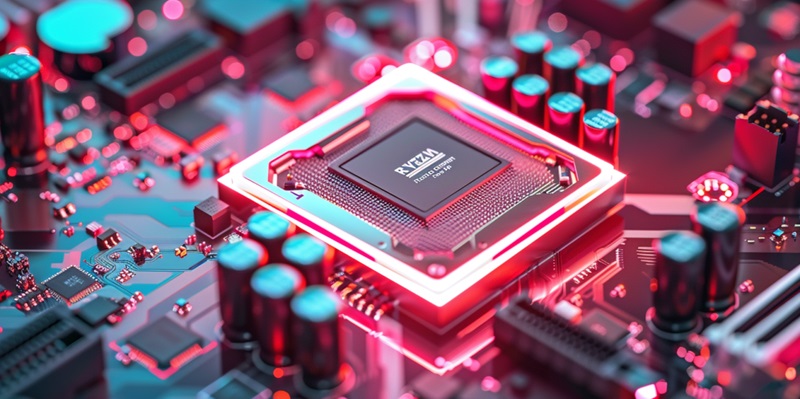In a market that continuously demands higher performance and better efficiency, AMD finds itself at a pivotal moment with its upcoming Ryzen 7 9700X processor within the highly anticipated Zen 5 lineup. Enthusiasts and experts have been particularly vocal since AMD confirmed that the new 9000 series, including the 9700X, will not surpass the gaming performance of the current 7000X3D models. This has led to a mix of disappointment and curiosity regarding AMD’s strategy and the technical improvements they may introduce to balance expectations and feasibility.
Adjusting Power and Performance Parameters
Rumored Increase in Thermal Design Power (TDP)
One of the biggest talking points is the rumored increase in the Thermal Design Power (TDP) of the Ryzen 7 9700X from its initially planned 65W to a significantly higher 120W, nearly doubling its power consumption. This increase in TDP is expected to allow the processor to achieve higher clock speeds, hence improving overall performance. Such a move would be essential to address critiques regarding the 9700X’s gaming capabilities, which have been a notable point of contention. As gaming performance is a crucial metric for many buyers in the high-performance computing market, boosting TDP could make the 9700X a more attractive option.
The decision to increase TDP is not without its risks. Higher power consumption requires careful consideration of thermal design and stability. Rapid adjustments to such parameters, especially so close to the rumored release date, raise questions about the reliability and thoroughness of AMD’s development process. Ideally, these aspects should have been optimized well ahead of launch. However, this could also be seen as a proactive approach from AMD to adapt to feedback and market demands swiftly, thereby aligning the new processor more closely with competitive expectations.
Impact on Base and Boost Clock Speeds
The initial plan to reduce the TDP to 65W from the Ryzen 7700X’s 105W led to a significant decrease in base clock speed—from 4.5GHz to 3.8GHz. This reduction, while aiding in power efficiency, adversely affected the Ryzen 7 9700X’s gaming performance metrics. Hence, the reconsideration of TDP appears to be aimed at counteracting this drop in clock speed, subsequently enhancing the chip’s overall competitiveness. If the increase to 120W TDP materializes, we could see a substantial rise in both base and boost clock speeds, potentially restoring the processor’s gaming prowess.
These adjustments in clock speed underscore the delicate balance AMD must strike between performance and energy efficiency. Higher clock speeds can lead to improved performance in gaming and other high-demand applications. However, they also necessitate better cooling solutions and can result in increased energy consumption. As such, these technical balancing acts reflect AMD’s broader strategy to compete in a market where both performance and power efficiency are highly valued by consumers. The increased TDP could indeed make the Ryzen 7 9700X a more compelling choice for gamers and high-end users who have been skeptical of its initial specifications.
Navigating Feedback and Perception
Addressing Negative PR and Market Expectations
The public acknowledgment by AMD that the 9700X would not surpass the 7000X3D in gaming performance has had a significant impact on market perception. Many saw this as AMD falling short of its competition, raising concerns about the company’s ability to innovate at the top end of the market. The rumored changes in TDP and consequent performance enhancements could be viewed as a direct response to these concerns. By making such adjustments, AMD appears to be actively addressing the negative PR fallout and seeking to restore confidence among its customer base and industry partners.
Such a reactive measure so late in the development phase can be perceived in various ways. On one hand, it demonstrates AMD’s responsiveness to market feedback and its commitment to delivering products that meet consumer expectations. On the other hand, it can be seen as a sign of desperation or indecision, suggesting that the company is scrambling to make last-minute changes in an attempt to avert a potential backlash. Either way, the results of this adjustment will be closely scrutinized by both fans and critics once the processor is officially released.
Balancing Technological Feasibility and Market Dynamics
In a market perpetually driven by demands for higher performance and superior efficiency, AMD stands at a critical juncture with the forthcoming release of its Ryzen 7 9700X processor, part of the eagerly awaited Zen 5 lineup. Enthusiasts and industry experts have been notably vocal ever since AMD confirmed that the new 9000 series, including the 9700X, will not outperform the gaming capabilities of the existing 7000X3D models. This revelation has sparked a blend of disappointment and intrigue among the tech community. Questions have arisen about AMD’s strategic direction and the specific technical enhancements they might introduce to manage this gap between expectation and reality. Speculation is rife about whether AMD focuses on different performance aspects, such as power efficiency or productivity improvements, to strike a balance that could satisfy both gamers and professionals. The upcoming months are likely to bring further insights into AMD’s plans and whether the company can navigate this pivotal moment effectively.

